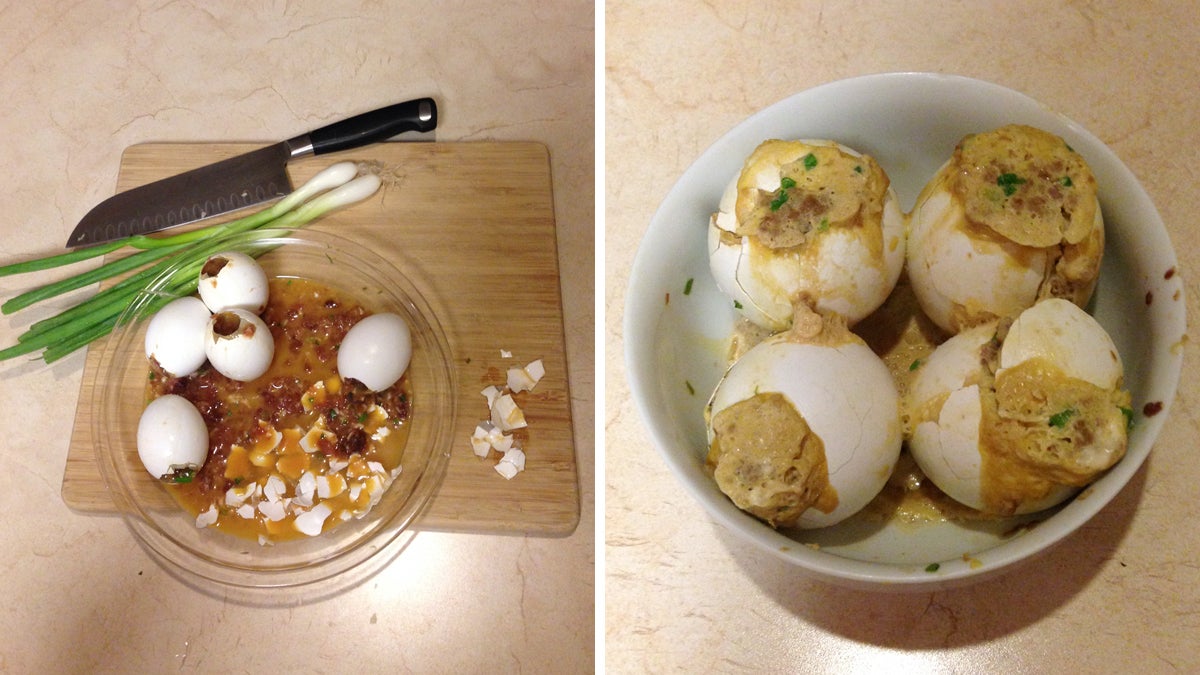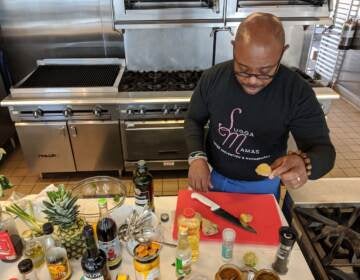When the chef is better off ordering Chinese take-out
When Mrs. Smithson asked me to cook them "an authentic Chinese dinner," I couldn't say no. How could I tell them that I was almost 23 but had never learned to boil water?

The author recreates the 'authentic Chinese dinner' experience from almost 60 years ago. (Annabel Liu
Like many Chinese-American immigrants, I spent my formative years in China and later in Taiwan, where the role of children was well defined: Study hard, and excel in examinations. Little was expected of us other than to devote every ounce of our youthful energy to school work.
The day after my arrival in this country to pursue graduate studies, I suddenly felt like a player who found someone had switched the rules in the middle of the game. I knew how to study and take tests, but did I have to cook my meals, too?
Forever favoring the direction of the least resistance, I soon moved into a girls’ co-operative house where meals were served. I thought I had my problem licked, until I met the Smithsons.
The Smithsons, my “friendship family” through the good work of the Foreign Student Adviser’s Office, invited me a few times for dinner. I was suffering from a severe case of homesickness and found their hospitality and interest in everything Chinese heartwarming.
A request I can’t refuse
When Mrs. Smithson asked me to cook them “an authentic Chinese dinner,” I couldn’t say no. With those five pairs of eyes looking at me so expectantly, how could I tell them that I was almost 23 but had never learned to boil water?
I went back to the co-op house that night feeling as desperate as a non-swimmer forced to dog paddle her way across the English Channel. Fortunately, my mother had had the foresight to provide a life buoy — a cookbook she had slipped in my suitcase before I left home. I spent a good part of two nights leafing through the book, fairly dog-earing it in the process.
To plan one dinner from a 109-page cookbook with nearly 150 entrees should not have been such a difficult task. In this case, however, I had some unusual considerations.
First, I had to eschew all dishes requiring ingredients that, according to the author, could be purchased “in any market in Shanghai.” For the same reason, delicacies such as eels and squab had to be scrapped. Next I chopped off all main courses that required cutting meat, whether to cubes, slices, shreds, or dices, for the simple reason I had never used a knife in my life. For good measure, I also deep-sixed anything that called for deep-frying.
Not too many candidates survived that ruthless pruning process, it’s true. Among the remaining recipes, the shortest entrée, called Yaogun Dan, literally “rock ‘n’ roll eggs,” caught my attention.
At the time, a typical Chinese cookbook only gave a list of ingredients and a vague description of the process, no measurements or photos. This volume was no exception. For rock ‘n’ roll eggs, three lines said it all. The author described it as an easy and interesting dish from a city famous for its cuisine, Suzhou. All one needed to do was:
Drill a tiny hole (the book didn’t specify with what tool; perhaps it was public knowledge) in each egg and empty its contents
Mix with soy sauce, salt, sugar, minced scallions, and ground pork
Return the mixture to the shell and steam the eggs until done.
I figured I could handle that.
Let’s get cracking
I had probably seen people crack an egg before in my life, but I had never physically held a raw egg in my hand. If learning how to crack an egg should have been my cooking lesson number one, drilling a tiny hole in it would have qualified as the final exam.
Unarmed with such vital insight, I discovered on the appointed day that eggshell tends to crack at the slightest pressure and that a jagged little hole soon gives way to a large one. Before I knew it, the shell gave out, allowing the Smithsons’ gleaming kitchen counter and floor a generous taste of the uncooked dinner, while the five members of the Smithson family waited to be fed.
Switching frantically from a small knife to scissors yielded similar results. After nearly half of the two-dozen eggs suffered the same fate, even Mr. Smithson, who had been watching television in the living room, became involved. Observing his dinner in jeopardy and his wife, grim-faced, busy wiping the counter and floor, he volunteered to rush out to buy another dozen.
There was, however, another problem the cookbook hadn’t mentioned: The white and yolk, which used to fit perfectly in their shell, after being beaten vigorously and joined by the other ingredients, became the genie that wouldn’t go back in the bottle. Mrs. Smithson solved the problem by throwing the excess in the garbage. Who could blame her after what the mixture had done to her kitchen?
The cookbook specified using “sturdy paper” to seal the holes “securely.” Since it was before the age of Saran Wrap and I had no clue what paper to use, I decided to leave those gaping holes alone. Why bother to seal them? The eggs would be steamed in a few minutes, I reasoned. Would we need to worry about dust falling into the holes?
Now that all the eggs were nice and full, I heaved a sigh of relief and proceeded to clean their exterior with a damp towel, a nice final touch of my own improvisation. The Smithson’s four-year-old daughter Debbie, dropping in to check on the progress of dinner, giggled when I told her that those eggs were getting “a sponge bath.” I even had time to steal a glance at my watch — it was an hour and half past our designated dinnertime.
Mrs. Smithson brought me several Pyrex pie plates. As soon as I began to transfer the eggs from their nestling place of the egg cartons to the plate, I realized why they were named “Rock ‘n’ Roll Eggs.” Did they rock and roll! Before I could right one humpty dumpty, another would fall, spilling its runny guts all over the plate. This modern-day Sisyphus had her hands full, scooping up the mixture to refill the eggs, time and again.
Quick to sense something had gone seriously awry, Debbie began to cry, screaming, “Mommy, Mommy, I don’t want Chinese food! I want a peanut butter sandwich!”
Never again
It’s too painful to recount how those eggs, after countless sponge baths, managed to be steamed and get on the Smithsons’ dinner table, set with polished silver and fresh flowers and aglow with candles, in honor of the feast. Suffice it to say that Debbie cried again because her mother wouldn’t let her add cream and sugar to “the rice pudding.”
Debbie was right. My first attempt at cooking rice had yielded a dish that was indeed like pudding.
Years have gone by since that horrendous night. Whenever I thought about it, my cheeks would burn, my palms would break out in a cold sweat, and I would feel ashamed and apologetic all over again. The poor Smithsons! They probably did eat peanut butter sandwiches before bed, and they probably never tried Chinese food again.
As for me, I developed a rather severe case of PTSD. For the next almost 60 years, I tried, although not always successfully, to keep cooking at arm’s length.
Nietzsche once said (Perhaps he said it many times, but since Nietzsche was his usual biting self, ouch! once was quite enough): “Bad cooks — and the utter lack of reason in the kitchen — have delayed human development longest and impaired it most.” I don’t mean to sound paranoid, but I have a sneaking suspicion that he was speaking about the likes of me.
WHYY is your source for fact-based, in-depth journalism and information. As a nonprofit organization, we rely on financial support from readers like you. Please give today.



